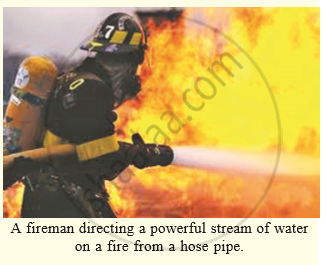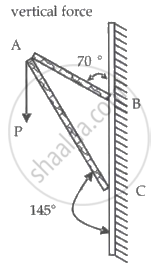Advertisements
Advertisements
Question
According to the third law of motion, when we push on an object, the object pushes back on us with an equal and opposite force. If the object is a massive truck parked along the roadside, it will probably not move. A student justifies this by answering that the two opposite and equal forces cancel each other. Comment on this logic and explain why the truck does not move.
Solution
- The truck has a large mass. Therefore, the static friction between the truck and the road is also very high.
- To move the car, one has to apply more force more than the static friction. Therefore, when someone pushes the truck and the truck does not move, then it can be said that the applied force in one direction is cancelled out by the frictional force of equal amount acting in the opposite direction.
- Therefore, a large, unbalanced force is required to move the truck.
- Therefore, the student is right in justifying that the two opposite and equal cancel each other.
APPEARS IN
RELATED QUESTIONS
Explain, why is it difficult for a fireman to hold a hose, which ejects large amounts of water at a high velocity.
A stone of 1 kg is thrown with a velocity of 20 m s−1 across the frozen surface of a lake and comes to rest after travelling a distance of 50 m. What is the force of friction between the stone and the ice?
If a man jumps out from a boat, the boat moves backwards. Why ?
Explain why, a runner presses the ground with his feet before he starts his run.
Draw a diagram to show how a rocket engine provides a force to move the rocket upwards. Label the diagram appropriately.
State Newton’s third law of motion and give two examples to illustrate the law.
Explain why, when a fireman directs a powerful stream of water on a fire from a hose pipe, the hose pipe tends to go backward.
Complete a sentence and explain it.
The working of a rocket depends on Newton's ______ law of motion.
While catching a cricket ball the fielder lowers his hands backwards. Why?
Consider a frame that is made up of two thin massless rods AB and AC as shown in the figure. A vertical force `vec"P"` of magnitude 100 N is applied at point A of the frame.

Suppose the force is `vec"P"` resolved parallel to the arms AB and AC of the frame.
The magnitude of the resolved component along the arm AC is xN.
The value of x, to the nearest integer, is ______.
[Given: sin(35°) = 0.573, cos(35°) = 0.819, sin(110°) = 0.939, cos(110°) = –0.342]
